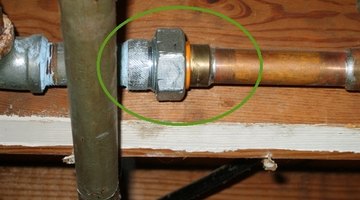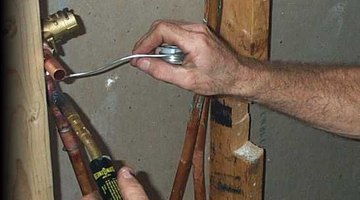Can You Connect Copper Pipe to Galvanized Pipe?
You'll need basic plumbing skills and tools, but the most important item you'll need is a dielectric fitting. This fitting joins a copper pipe to a galvanized pipe, called a 'union'.

When water flows through pipes of two different metals, the pipes will become eroded by electrical impulses from the slight acidity found in all water sources. This eventually causes pipe degradation and leakage. The fitting is generally made of galvanized steel and bronze, tightened together in a union, with a small rubber or plastic washer between them, stopping any electrical flow from degrading the connection.
Tools for the job

You'll need a pipe wrench, hacksaw for cutting the pipe to fit, some pipe tape or pipe thread compound to cover the threads, and a torch to "sweat," or solder, the copper pieces together.
Getting the job done

The easiest way to connect the copper and galvanized pipes is to use your wrench and unscrew the galvanized piece from the connecting threads. Next, connect copper pipes together until you reach the galvanized pipe threads. Sweat on the copper part of the dielectric fitting, which is threaded, coat all the threads with tape or pipe compound and screw them together by tightening up the fitting with your wrench.
Where to find them
Dielectric fittings or dielectric unions, as they are often called, can be found at virtually any hardware store in the plumbing department, or online by searching for plumbing parts and then searching for dielectric fitting or unions. They are fairly inexpensive, in the $5 or less price range, and will come with all the parts needed, including the washer, so you won't have to purchase any other part.
The Drip Cap
- You'll need basic plumbing skills and tools, but the most important item you'll need is a dielectric fitting.
- This eventually causes pipe degradation and leakage.
- Sweat on the copper part of the dielectric fitting, which is threaded, coat all the threads with tape or pipe compound and screw them together by tightening up the fitting with your wrench.
References
Resources
Writer Bio
Dale Yalanovsky has been writing professionally since 1978. He has been published in "Woman's Day," "New Home Journal" and on many do-it-yourself websites. He specializes in do-it-yourself projects, household and auto maintenance and property management. Yalanovsky also writes a bimonthly column that provides home improvement advice.
More Articles



